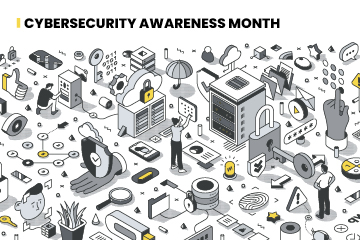When it Comes to Cybersecurity Threats, it’s Always Spooky Season!
The cyber threat is so significant and ever-changing that officials have dedicated the entire month of October to raise awareness about the importance of cybersecurity. In fact, this year marks the 20th anniversary of Cybersecurity Awareness Month, a collaborative effort between government and industry to enhance cybersecurity awareness, encourage actions by the public to reduce online risk, and generate discussion on cyber threats on a national and global scale. And while this 31-day focus is good, cybersecurity should be top-of-mind for each of us every day of the year. Need convincing? Check out the sheer number and different types of cybersecurity alerts and advisories from Cybersecurity Infrastructure Security Agency here.
Why is cybersecurity awareness and education critical?
To understand the importance of exercising cybersecurity awareness, consider these statistics:
- The average cost of a data breach in 2022 was $4.35 million (Cost of a Data Breach Action Guide).
- The median time for an attacker to access your private data through a phishing email is 1 hour and 12 minutes (New Windows 11 security features are designed for hybrid work).
- Fifteen percent of lifestyle apps are malicious (Leading malicious mobile app categories worldwide in 2018).
- There are 4,000 password attacks per second!
What can you do to protect yourself online at work and home?
Just as the tools and threats employed by cybercriminals continue to adapt to the defenses deployed against them, it’s critical your awareness, online behavior, and system networks constantly evolve to counter every move they make.
At MarCom Group + LMD, we’re constantly modernizing our training, and security policies and procedures to keep company and customer data safe. Here’s what we recommend for protecting yourself and your networks:
Multi-factor Authentication
Multi-factor authentication can protect 99.9 percent of the attacks on your accounts by offering stronger security than relying solely on passwords. Check your devices, apps, and account settings to enable multi-factor authentication, such as two-step authentication or biometrics.
Password Manager Implementation
Hackers don’t break in—they sign in. So, a good way to protect one of attackers’ most common entry points is by going password-less using a password manager. When passwords are needed, there are a few steps you can take to be safer:
- Use your browser’s password generator to create stronger passwords.
- Length—at least 12 characters—matters more than complexity, and a password manager can help you keep track.
- Schedule and make regular password changes to all your accounts and apps.
Virtual Private Network – Securing your connection when using open Wi-Fi while on travel
VPN is a service that gives you safe and private access to the internet. By encrypting your connection, a VPN hides your IP address and online activity from spying eyes and helps keep your data safe.
As security awareness is ultimately about managing human risks, remember you are cybersecurity, and you play a vital role in protecting your data and corporate data.
So… remember
- Use strong passwords.
- Use multi-factor authentication on all of your applications.
- Recognize and report phishing to IT department.
- Ensure your software, applications, and devices are up to date.
The most important thing to remember is that cybersecurity is a collective effort, and each of us plays a pivotal role in safeguarding our networks and keeping our data and corporate information secure. Cybersecurity is not just a single month of awareness but an ongoing commitment. And, with a smidgeon of luck and a lot of determination, your data, systems, and network will be well protected. Stay vigilant.


